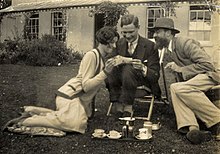Rosamond Lehmann
Rosamond Nina Lehmann , (born February 3, 1901 in Bourne End , Buckinghamshire , died March 12, 1990 in London ) was a British writer.
Private life
Rosamond Lehmann was the second child of Rudolph Chambers Lehmann and his wife Alice Marie Davis. Her Jewish family had roots in Germany, Scotland and America, among others. Her father was a journalist ( Punch , The Daily News , Granta ) and from 1906 to 1910 a member of the British House of Commons ; her great-grandfather Leo Lehmann and her great uncles Rudolf Lehmann and Henri Lehmann were well-known painters; her grandfather was the publisher Robert Chambers . Her older sister was Helen Chambers Lehmann (1899–1985), the younger siblings were the future actress Beatrix and the future poet and publisher John .
Her parents are said to have preferred the other siblings according to her statement, which is why Rosamond felt abandoned and was active as a writer and especially wrote early on. She was raised at home and then studied in Cambridge at Girton College (not yet part of the university at the time). She graduated from college with degrees in English (1921) and Modern / Medieval Languages (1921) and published articles in her father's magazine. During her time in Cambridge, she also met Leslie Runciman, whom she married on December 20, 1923. They moved to Newcastle upon Tyne , but they separated from him in 1927 after he had a forced abortion. In 1928, after their divorce, she married Wogan Philipps , with whom she lived in Ipsden, Oxfordshire . She was happier in this marriage than in the previous one; the couple also had son Hugo (1929) and daughter Sarah (1934). Finally, this marriage also fell apart in 1939/40 because her husband was fighting in the Spanish Civil War. Rosamond had an affair with Goronwy Rees, and from 1941 a publicly noticed affair with Cecil Day-Lewis . She lived with him for nine years and in the meantime divorced Wogan Philips (1944). When Day-Lewis divorced in 1950, he married Jill Balcon in 1953.
Her private life was badly shaken in 1958 by the death of her 24-year-old daughter Sarah (Sally), who died of polio , which she contracted in Jakarta . The mother lost all interest in writing and devoted herself to a self-developed form of spirituality that focused on her lost daughter. When she finally began to write again, this belief also influenced her last works, in which she documented her contacts with the otherworldly Sally.
plant
Rosamond Lehmann's work was largely autobiographical. She described and developed her characters from their emotional world and is therefore considered a representative of the English psychological novel. Her work remained untranslated for a long time; her first success with Dusty Answer was initially considered her major work. Because she described women as sexual beings, the novel became controversial. Your second work contains a homosexual component, which led to a fundamental rejection in the reviews. It was not until the novels Invitation to the Waltz and The Weather in the Streets that she was considered a bestselling author. Her fame had long faded by the 1980s, but was reawakened by a reprint of the early novels.
- Dusty Answer (1927, Girl on the Search / Dark Answer 1927)
- A Note in Music (1930)
- Invitation to the Waltz (1932, invitation to waltz 1937)
- The Weather in the Streets (1936, Like the Wind in the Streets )
- No More Music (1939)
- The Ballad and the Source (1944)
- The Gipsy's Baby & Other Stories (1946)
- The Echoing Grove (1953, The Buried Day )
- The Swan in the Evening: Fragments of an Inner Life (1967, Der Schwan am Abend )
- A Sea-Grape Tree (1976)
- Moments of Truth (1986)
Honors
- Commander of the British Empire 1982.
- President of the UK Branch of PEN
Individual evidence
- ↑ a b c d Interview by the Paris Review , 1985.
- ^ Antonius Lux (ed.): Great women of world history. A thousand biographies in words and pictures . Sebastian Lux Verlag , Munich 1963, p. 292
| personal data | |
|---|---|
| SURNAME | Lehmann, Rosamond |
| ALTERNATIVE NAMES | Lehmann, Rosamond Nina |
| BRIEF DESCRIPTION | English writer |
| DATE OF BIRTH | February 3, 1901 |
| PLACE OF BIRTH | Bourne End , Buckinghamshire |
| DATE OF DEATH | March 12, 1990 |
| Place of death | London |
